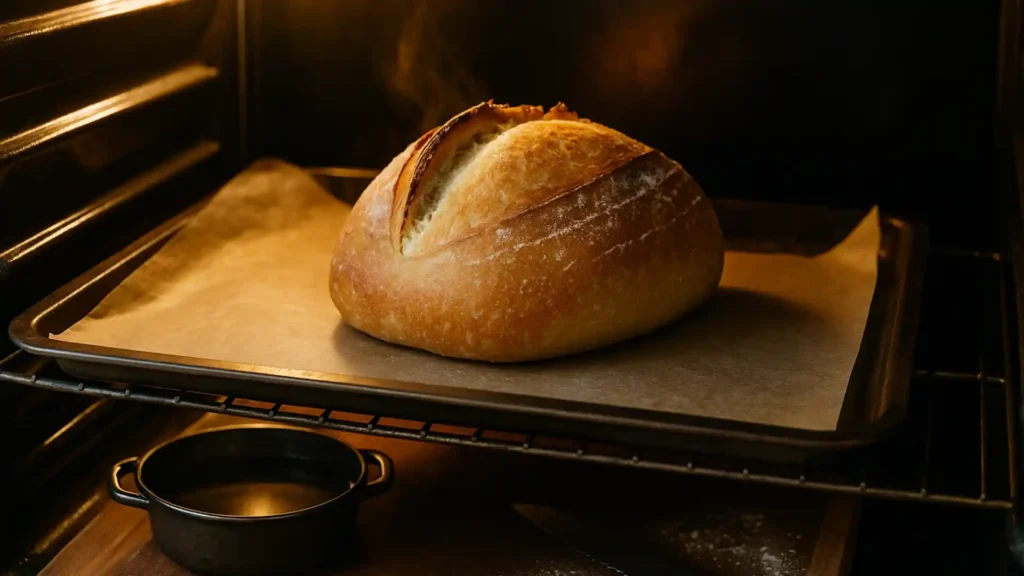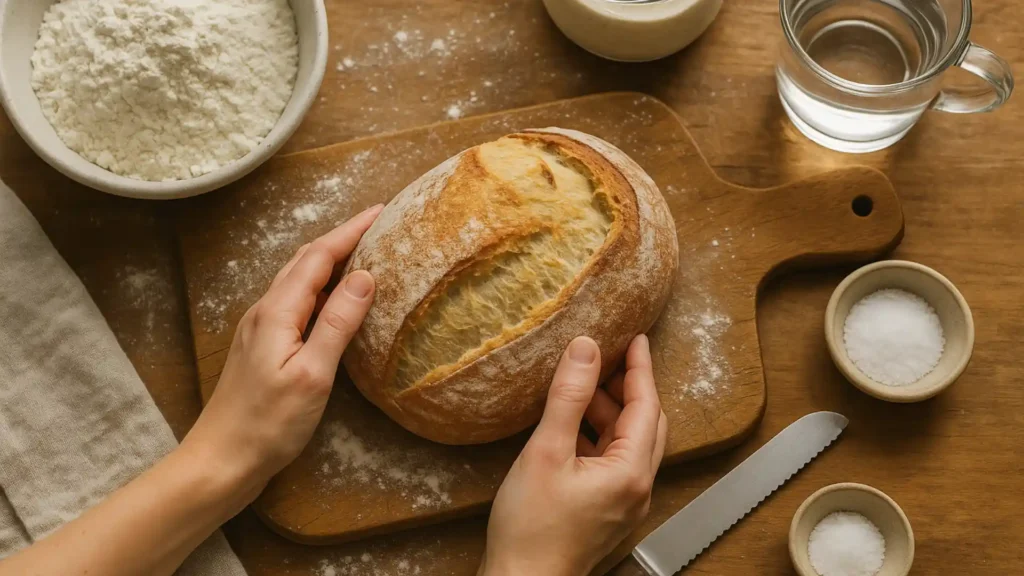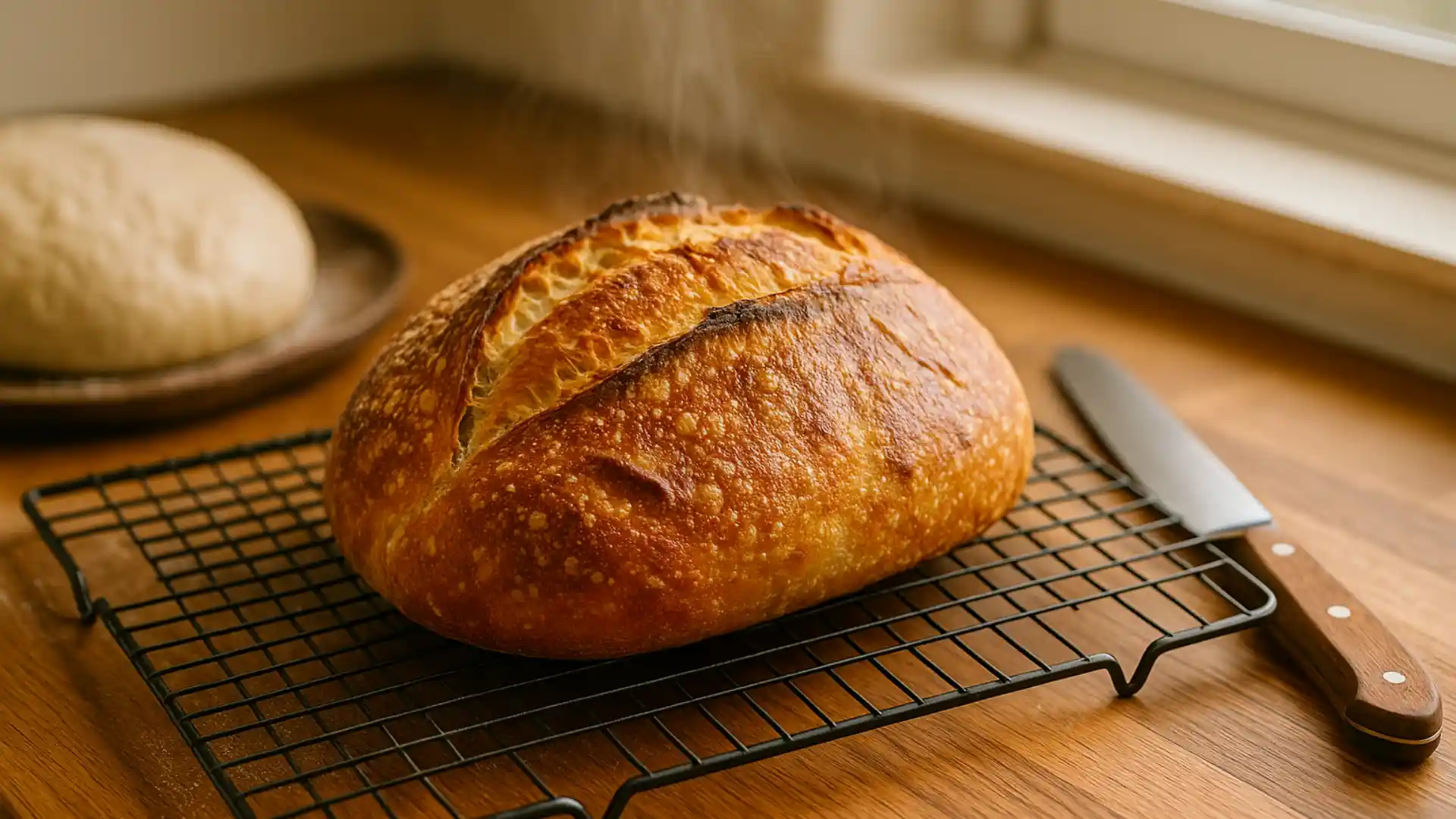How to Cook Sourdough Bread Without a Dutch Oven
There’s something magical about baking your own bread. The smell, the crackling crust, that first warm slice — it’s one of life’s simple joys. Most guides will tell you that you need a Dutch oven to get perfect sourdough, but the truth is, you don’t. You can absolutely make a beautiful loaf without one. In fact, learning how to cook sourdough bread without a Dutch oven opens up more flexibility in the kitchen.
From Tradition to Today
Sourdough has deep roots in Europe, where bakers worked with natural starters long before modern yeast. The Dutch oven became popular later because it traps steam and creates that golden, blistered crust. But not everyone has one, and that’s okay. In America, plenty of home bakers skip it and still bake loaves that rival their favorite bakery.
Why This Method Works
People love this approach because it’s simple. You can use a baking stone, a sheet pan, or even a regular casserole dish. With a few tricks — like adding steam in the oven — you’ll still get that rustic crunch outside and soft, tangy crumb inside.
I remember my first attempt without a Dutch oven. It was a cold winter afternoon, and I used nothing more than a cookie sheet and a pan of hot water. The result? A gorgeous loaf with a crisp crust that made me realize I didn’t need fancy equipment to enjoy homemade sourdough.
Ingredients for Sourdough Bread Without a Dutch Oven
The beauty of sourdough is that the ingredient list is simple. You don’t need anything fancy — just quality basics and a little patience.
Basic Ingredients
- 500 g bread flour (about 4 cups)
- 350 ml warm water (about 1 ½ cups)
- 100 g active sourdough starter (about ½ cup)
- 10 g salt (about 2 tsp)
- A little extra flour for dusting
Healthy Swaps & Alternatives
- Gluten-free → Use a high-quality gluten-free flour blend made for bread baking.
- Whole grain → Swap half the bread flour for whole wheat flour. It gives a nuttier taste and adds fiber.
- Extra nutrition → Mix in seeds like flax, chia, or sunflower seeds for added crunch and nutrients.
Tips for Choosing the Best Ingredients
- Flour matters: Go for bread flour instead of all-purpose. It has more protein, which gives your sourdough that chewy bite.
- Starter check: Make sure your sourdough starter is active and bubbly before baking. If it’s sluggish, your bread will be too.
- Water tip: Lukewarm water (not hot) is best — it helps the dough rise without killing the natural yeast.
Simple ingredients, but when handled right, they’ll turn into a loaf that tastes like it came from a bakery — no Dutch oven required.

Step-by-Step Instructions to Cook Sourdough Bread Without a Dutch Oven
You don’t need special gear for this. Just your dough, a hot oven, and a couple of kitchen hacks.
Step 1: Mix and Rest the Dough for Sourdough Bread Without a Dutch Oven
Combine flour, water, and sourdough starter in a big bowl. Stir until it comes together, then cover with a towel and let it rest for about 30 minutes. This short rest makes the dough easier to handle.
Step 2: Add Salt and Knead the Sourdough Bread Without a Dutch Oven
Sprinkle in the salt and knead gently for 5–7 minutes. Don’t stress — sourdough doesn’t need crazy kneading, just enough to build structure.
Step 3: First Rise of Sourdough Bread Without a Dutch Oven (Bulk Fermentation)
Transfer the dough into a lightly oiled bowl. Cover and let it sit at room temperature for 4–6 hours, or until it doubles in size. Warmer kitchens = faster rise.
Step 4: Shape the Sourdough Bread Without a Dutch Oven Loaf
Turn the dough out onto a floured surface. Shape it into a round or oval loaf and place it on a baking sheet lined with parchment paper.
Step 5: Second Rise of the Sourdough Bread Without a Dutch Oven
Let the shaped loaf rest for 45–60 minutes. This gives it a lighter texture once baked.
Step 6: Bake the Sourdough Bread Without a Dutch Oven with Steam
Preheat your oven to 450°F (230°C). Place a small pan of hot water on the bottom rack — this creates steam, which helps develop that crackly crust. Put your sourdough on the middle rack and bake for 35–40 minutes.
Step 7: Cool the Sourdough Bread Without a Dutch Oven Before Slicing
As tempting as it is, don’t slice right away. Let the bread cool on a wire rack for at least 30 minutes. This keeps the inside fluffy instead of gummy.
Pro Tip: For an even crustier finish, remove the pan of water halfway through baking. This gives you the perfect balance of soft interior and crispy exterior.
That’s all it takes to bake a gorgeous loaf of sourdough bread without a Dutch oven — simple steps, no fancy tools.

Tips & Variations for Sourdough Bread Without a Dutch Oven
The best thing about sourdough bread without a Dutch oven is how versatile it can be. Once you’ve got the basic method down, you can play around with flavors and make it fit your lifestyle.
Flavor Upgrades
- Garlic and herb loaf → Add minced garlic and a teaspoon of rosemary or thyme into the dough.
- Cheesy sourdough → Sprinkle shredded cheddar or Parmesan on top before baking.
- Seeded crust → Roll your shaped loaf in sesame or sunflower seeds before the final rise for extra crunch.
Diet-Friendly Adjustments
- Gluten-free → Use a gluten-free flour blend and increase hydration (GF flour tends to be thirstier).
- Low-sodium → Reduce the salt in the recipe and balance flavor with herbs or spices.
- High-protein → Mix in chia seeds, flax seeds, or even a scoop of protein flour to boost nutrition.
Serving Suggestions
- Warm slices with a drizzle of olive oil and sea salt.
- Toasted and topped with avocado and eggs for a hearty breakfast.
- Served alongside soups, stews, or a fresh salad for a cozy dinner.
Little Hack: If you want that classic artisan look, use a sharp knife or razor to score the loaf before baking. It not only makes it prettier but also helps the bread expand evenly.
That’s the fun part — once you know how to cook sourdough bread without a Dutch oven, you can make every loaf unique.
Nutrition Facts: Sourdough Bread Without a Dutch Oven
Every loaf will vary a little depending on your flour and add-ins, but here’s an average breakdown per slice (about 60 g):
- Calories: ~170
- Carbs: ~35 g
- Protein: ~6 g
- Fat: ~1 g
- Fiber: 2–3 g
- Sodium: ~180 mg
What This Means for You
- It’s hearty but not overly heavy, making it a solid base for meals.
- The carbs give you long-lasting energy, while the protein keeps you full.
- Sourdough’s natural fermentation process makes it easier to digest than many other breads.
- If you choose whole wheat flour or add seeds, you’ll boost the fiber even more.
Tip: Pair your slice with protein (like eggs, hummus, or chicken) and some veggies for a balanced plate.
Bottom line: sourdough bread without a Dutch oven gives you the same wholesome nutrition as traditional sourdough — without needing fancy equipment.
Common Mistakes When Baking Sourdough Without a Dutch Oven (and Fixes)
Even though baking sourdough bread without a Dutch oven is simple, a few common hiccups can happen. Here’s how to avoid them — or fix them if they pop up.
Mistake 1: Burnt Crust, Undercooked Inside
This happens when the oven is too hot or you bake on a thin tray.
Fix it: Lower the oven temp slightly (to 425°F / 220°C) and bake a little longer. Using a thicker baking sheet or pizza stone also helps.
Mistake 2: Pale, Soft Crust
No Dutch oven means you need steam to get that bakery-style crust.
Fix it: Add a pan of hot water to the bottom rack for the first 15–20 minutes, or spritz the oven walls with water right after loading the loaf.
Mistake 3: Gummy, Dense Center
If you slice too soon, the steam inside makes the crumb gummy.
Fix it: Let the bread rest at least 30 minutes before cutting. If the dough itself was under-proofed, give it a longer rise next time.
Mistake 4: Flat Loaf
This usually means the dough was too slack or proofed too long.
Fix it: During shaping, add a few extra folds to strengthen the dough. Also, bake as soon as it passes the “poke test” (dough springs back slowly when pressed).
Bonus Tip: If your loaf doesn’t look picture-perfect, don’t panic. Even “ugly” sourdough usually tastes amazing — and you can always turn less-than-perfect bread into croutons, toast, or breadcrumbs.
So, even without a Dutch oven, you can troubleshoot your way to a crusty, flavorful loaf every time.
FAQ – Sourdough Bread Without a Dutch Oven
Can I really get the same crust without a Dutch oven?
Yes, you can. A Dutch oven helps by trapping steam, but you can mimic that effect with a hot pan of water in the oven or by spritzing the loaf and oven walls. The result is a crisp, golden crust that rivals Dutch oven bread.
What’s the best alternative to a Dutch oven?
A baking stone or steel works beautifully since it holds heat and gives the loaf a strong rise. If you don’t have one, a heavy baking sheet will still do the job.
Can I prepare the dough ahead of time?
Absolutely. One of the perks of sourdough is slow fermentation. You can proof the dough overnight in the fridge, then bake it the next day. This often makes the flavor even better.
How should I store sourdough bread?
Once baked, wrap it in a clean kitchen towel or place it in a paper bag. This keeps the crust from going soft. For longer storage, slice and freeze it, then toast or reheat slices straight from the freezer.
Can I use regular yeast instead of sourdough starter?
Technically, yes — but then it’s not sourdough. If you substitute yeast, you’ll lose that tangy flavor and some of the digestive benefits. Stick with starter if you want the true sourdough experience.
In short: baking sourdough bread without a Dutch oven is not only possible but also flexible. With the right tricks, you won’t miss the pot at all.
Conclusion: Sourdough Without the Dutch Oven
At the end of the day, learning how to cook sourdough bread without a Dutch oven proves that you don’t need fancy tools to make something amazing. With a hot oven, a little steam, and some patience, you’ll still get that golden crackly crust and soft, chewy crumb that makes sourdough so loved around the world.
If you’ve never tried it, this is your sign to bake a loaf. Start simple, then experiment with herbs, seeds, or even cheese on top. Every loaf tells a story, and yours will taste even better when you know you baked it yourself.
I’d love to hear how your sourdough turns out! Share your experience in the comments — did you try a baking stone, a sheet pan, or maybe a casserole dish? Your tips could help other home bakers.
And if you’re hungry for more sourdough inspiration, check out these recipes and guides:
- Take and Bake Sourdough Bread
- How to Make Sourdough Bread Without Starter
- Sourdough Bread and Cheese
- How to Make Gluten-Free Sourdough Bread
That’s it — now you know exactly how to bake a gorgeous sourdough loaf without a Dutch oven. Simple, rustic, and delicious.
